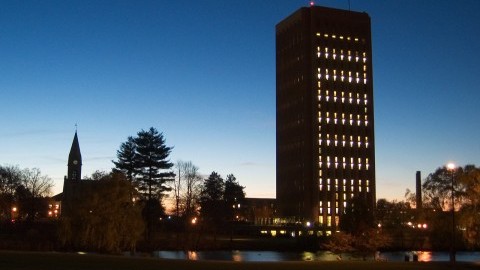Doug Marshall, the interim director of Campus Planning at UMass Amherst, presented the 2017 update on the campus’ master plan on Wednesday, showing both recently completed and future campus development projects.
UMass’ current master plan, created in 2012, provides a framework for the campus where infrastructure development and the overall design of the campus looks to progress in the next 30 or 40 years. The master plan was developed extensively over the course of more than 350 hours and with the help of a variety of consultants and groups located both on and off campus.
Goals of the master plan include creating more efficient and sustainable buildings while expanding the amount of open space on campus. The plan also attempts to direct vehicle traffic to the outskirts of campus, while also respecting the deep building heritage of many older buildings and staying within the campus boundaries.
“[The master plan] was in part prompted by us realizing we were going to be doing a large amount of capital project work over the following five years,” said Marshall. “We wanted to get a sense of what kind of build out we could have on campus and stay within the borders that we had at the time.”
Various projects that have been completed since the adoption of the master plan were shown, including additions to the McGuirk Alumni Stadium completed in 2014, the improvement of the central campus infrastructure completed in 2014 and the restoration of the Old Chapel completed in 2016.
Marshall also emphasized the use of the buddy building concept, which entails the expansion of older buildings rather than full renovations, which allows for faculty to move out of older buildings and into these new additions. The buddy building concept was used to expand South College and to move various faculty members out of Bartlett hall, which is struggling with structural issues within its walls.
According to Marshall, “[Under the buddy building concept], we get some cost efficiencies with the total project, we get to rejuvenate these historic buildings, and it seems like a win-win for the campus, for the historic preservation interests in the community.”
In addition, Marshall noted various environmental and sustainability efforts of the various projects, including the development of solar canopies and the construction of buildings that satisfy certain LEED standards for sustainability.
“All of our projects are at least LEED silver,” Marshall said. “We have had a series of buildings that have exceeded that. We are trying to be as sustainable as we can with all of the work that we do.”
Some members of the audience were concerned with whether the campus is taking enough steps toward sustainability. Jim Turner, an Amherst resident and one member of the audience of about 20 people, expressed such concerns.
“I was happy to hear there are at least a LEED silver mandate on buildings,” Turner said, “but I think that is actually pretty low. It should be at least a gold or platinum LEED, a more environmentally friendly building standard.”
Marshall went on to explain future projects currently under development and soon to begin development. Projects near completion include an addition to the Isenberg School of Management and a new Physical Sciences Building, both with expected completion dates in 2018. More long-term projects consist of renovations to the Student Union and the building of a new Worcester Dining Commons, both expected to be completed in the Fall of 2020.
Hana Kolton, a resident of Boston and member of the audience, was satisfied with the direction UMass is expanding its campus.
“I think it seems to be growing, but it seems to be growing in its own area,” Kolton said. “It’s expanding in the sense that they are starting to renovate some of the old buildings within the master plan, so that is always a good thing.”
Will Mallas can be reached at [email protected].




















